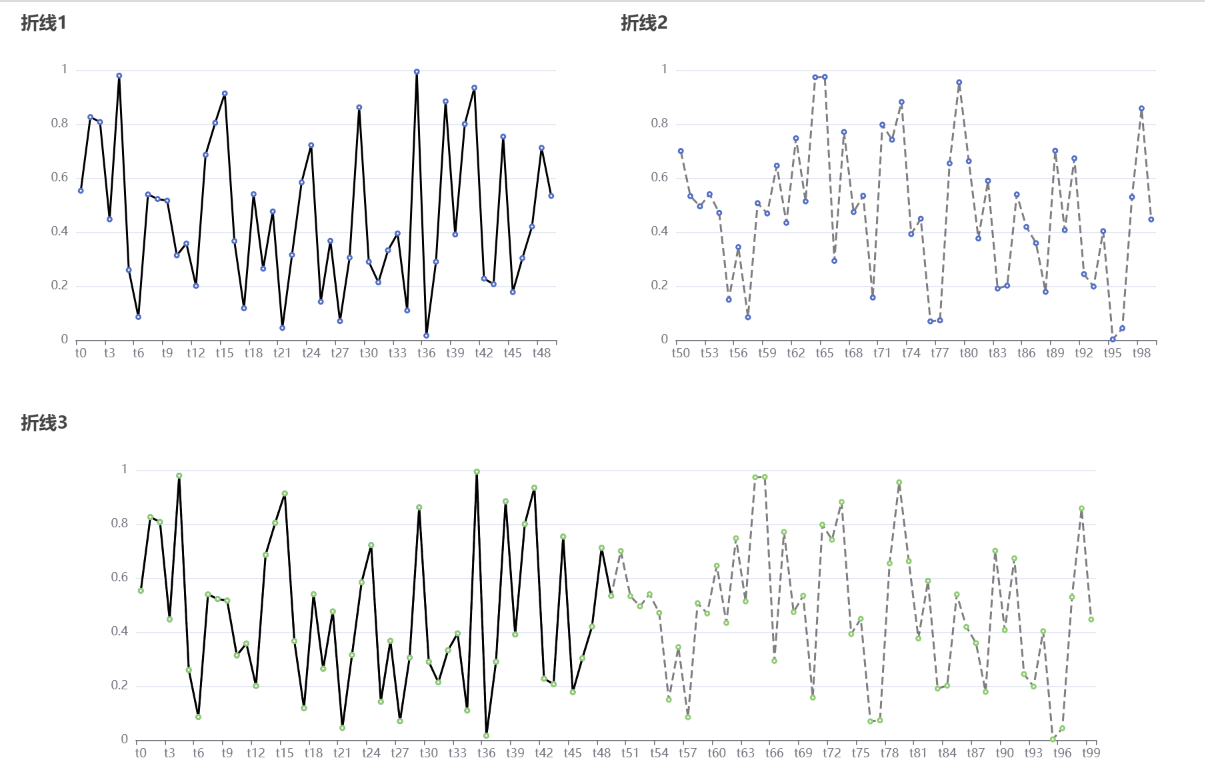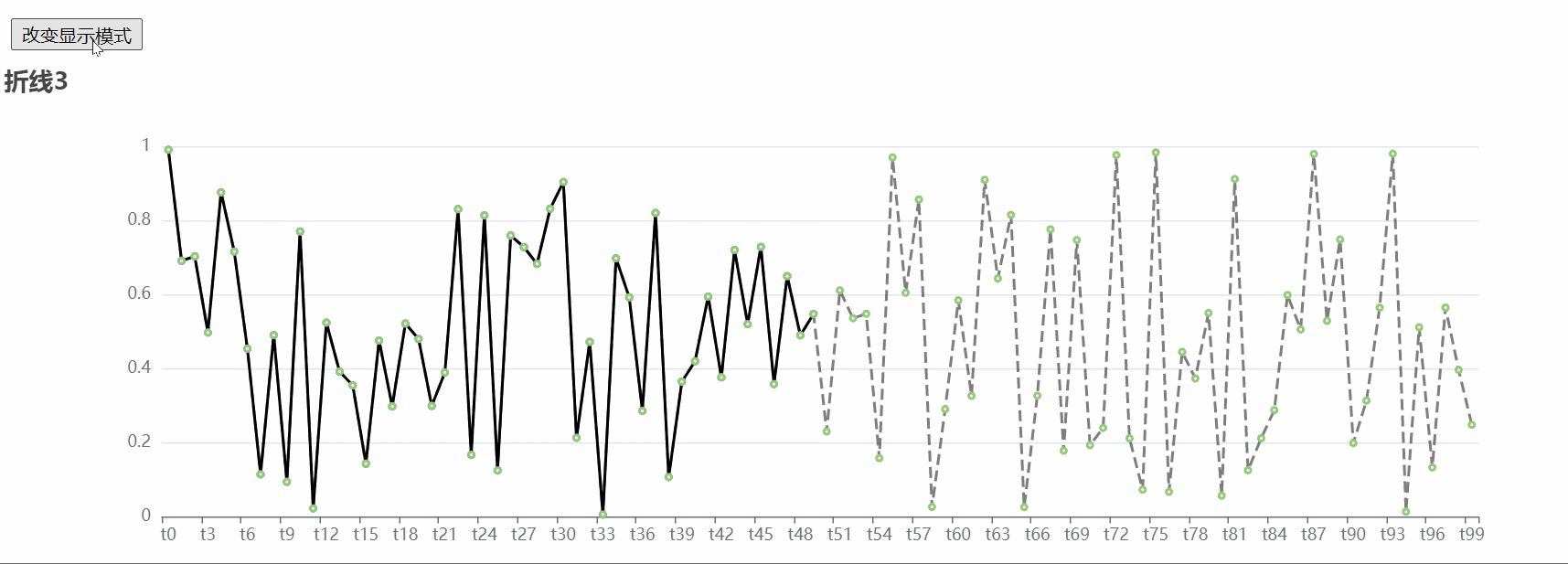①效果

折线1和折线2为拆分版本,折线3为合并版本。
合并方法是采用两个series元素,并分别设置lineStyle
最开始参考(https://blog.csdn.net/weixin_33991418/article/details/89369690),在折线2数据组前面插入大量“-”,这样就可以把折线2数据组推到折线1数据组之后显示,后面发现多此一举。直接连接两个数据组,通过折线图的重叠也可以达到相同效果,并且还无需额外处理实现了交点(t50和t51)的连线。
②原生JS版本
<!DOCTYPE html> <html> <head> <meta charset="utf-8" /> <title>ECharts</title> <!-- 引入刚刚下载的 ECharts 文件 --> <script src="echarts.js"></script> <style> main { /*对子元素开启弹性布局*/ display: flex; /*弹性元素在必要的时候换行*/ flex-wrap: wrap; /*将弹性元素居中*/ justify-content: center; } </style> </head> <body> <main> </main> <script type="text/javascript"> const WIDTH = 600; const HEIGHT = 400; // main用来放div1 div2 div3 let container = document.querySelector('main') // div1用来放折线图1 let div1 = createDiv(WIDTH, HEIGHT) container.appendChild(div1) // div2用来放折线图2 let div2 = createDiv(WIDTH, HEIGHT) container.appendChild(div2) // div3用来放折线图3 let div3 = createDiv(WIDTH * 2, HEIGHT, 'none') container.appendChild(div3) // 创建空图 let lineChart1 = echarts.init(div1) let lineChart2 = echarts.init(div2) let lineChart3 = echarts.init(div3) // 模拟两份数据 const DATA_SIZE = 100; let packets = makeDate(DATA_SIZE) let packets1 = packets.slice(0, DATA_SIZE / 2) let packets2 = packets.slice(DATA_SIZE / 2, DATA_SIZE) // 将数据填充到折线图 lineChart1.setOption({ title: { text: '折线1', }, xAxis: { data: packets1.map(p => p.time) }, yAxis: {}, series: [ { data: packets1.map(p => p.data), type: 'line', lineStyle: { color: 'black', } } ] }) lineChart2.setOption({ title: { text: '折线2', }, xAxis: { data: packets2.map(p => p.time) }, yAxis: {}, series: [ { data: packets2.map(p => p.data), type: 'line', lineStyle: { color: 'black', type: 'dashed', opacity: 0.5, } } ] }) lineChart3.setOption({ title: { text: '折线3', }, xAxis: { data: packets1.concat(packets2).map(p => p.time) }, yAxis: {}, series: [ { data: packets1.map(p => p.data), type: 'line', lineStyle: { color: 'black', } }, { data: packets1.concat(packets2).map(p => p.data), type: 'line', lineStyle: { color: 'black', type: 'dashed', opacity: 0.5, } } ] }) function createDiv(width, height, display = 'block') { let result = document.createElement('div') result.style.width = width + 'px' result.style.height = height + 'px' // result.style.display = display return result } function makeDate(dataSize) { let result = []; for (let i = 0; i != dataSize; ++i) { result.push({ time: "t" + i, data: Math.random(), }) } return result; } </script> </body> </html>
③Vue.js版本

依赖及其版本:
"dependencies": { "core-js": "^3.6.5", "echarts": "^5.3.0", "vue": "^2.6.11", "vuex": "^3.6. "dependencies": { "core-js": "^3.6.5", "echarts": "^5.3.0", "vue": "^2.6.11", "vuex": "^3.6.2" },2" },
main.js:
import Vue from 'vue' import App from './App.vue' import store from './store' //引入echarts 5.0版本以上要使用如下引用方式 import * as echarts from 'echarts' Vue.config.productionTip = false Vue.prototype.$echarts = echarts new Vue({ render: h => h(App), store, }).$mount('#app')
store/index.js:
import Vue from 'vue' import Vuex from 'vuex' // 应用vuex插件 Vue.use(Vuex) const DATA_SIZE = 100 function makeDate(dataSize) { let result = []; for (let i = 0; i != dataSize; ++i) { result.push({ time: "t" + i, data: Math.random(), }) } return result; } let packets = makeDate(DATA_SIZE) let packets1 = packets.slice(0, DATA_SIZE / 2) let packets2 = packets.slice(DATA_SIZE / 2, DATA_SIZE) // 用于响应组件中的动作(业务逻辑放这里) const actions = { } // 用于操作state const mutations = { } // 用于存储数据 const state = { packets1, packets2, } // 创建并暴露store export default new Vuex.Store({ actions, mutations, state })
App.vue:
<template>
<div>
<button id="btnChange" @click="changeMode">改变显示模式</button>
<Chart1 v-show="mode === 1" />
<Chart2 v-show="mode === 2" />
</div>
</template>
<script>
import Chart1 from './components/Chart1.vue'
import Chart2 from './components/Chart2.vue'
export default {
name: 'App',
data() {
return {
mode: 1,
}
},
components: {
Chart1,
Chart2,
},
methods: {
changeMode() {
this.mode = (this.mode === 1) ? 2 : 1
}
},
}
</script>
<style>
#btnChange {
margin: 10px;
}
</style>
Chart1.vue:
<template> <main> <div id="realData" style=" 600px;height: 400px;"></div> <div id="predictedData" style=" 600px;height: 400px;"></div> </main> </template> <script> import { mapState } from 'vuex' export default { name: 'Chart1', computed: { ...mapState(['packets1', 'packets2']), }, mounted() { let div1 = document.querySelector("#realData") let div2 = document.querySelector("#predictedData") let lineChart1 = this.$echarts.init(div1) let lineChart2 = this.$echarts.init(div2) lineChart1.setOption({ title: { text: '折线1', }, xAxis: { data: this.packets1.map(p => p.time) }, yAxis: {}, series: [ { data: this.packets1.map(p => p.data), type: 'line', lineStyle: { color: 'black', }, }, ], }) lineChart2.setOption({ title: { text: '折线2', }, xAxis: { data: this.packets2.map(p => p.time) }, yAxis: {}, series: [ { data: this.packets2.map(p => p.data), type: 'line', lineStyle: { color: 'black', type: 'dashed', opacity: 0.5, }, }, ], }); }, } </script> <style scoped> main { display: flex; } </style>
Chart2.vue:
<template> <div> <div id="MyChart" style=" 1200px;height: 400px;"></div> </div> </template> <script> import { mapState } from 'vuex' export default { name: 'Chart2', computed: { ...mapState(['packets1', 'packets2']), }, mounted() { let myDiv = document.querySelector("#MyChart") let lineChart = this.$echarts.init(myDiv) lineChart.setOption({ title: { text: '折线3', }, xAxis: { data: this.packets1.concat(this.packets2).map(p => p.time) }, yAxis: {}, series: [ { data: this.packets1.map(p => p.data), type: 'line', lineStyle: { color: 'black', }, }, { data: this.packets1.concat(this.packets2).map(p => p.data), type: 'line', lineStyle: { color: 'black', type: 'dashed', opacity: 0.5, }, }, ], }); }, }; </script>